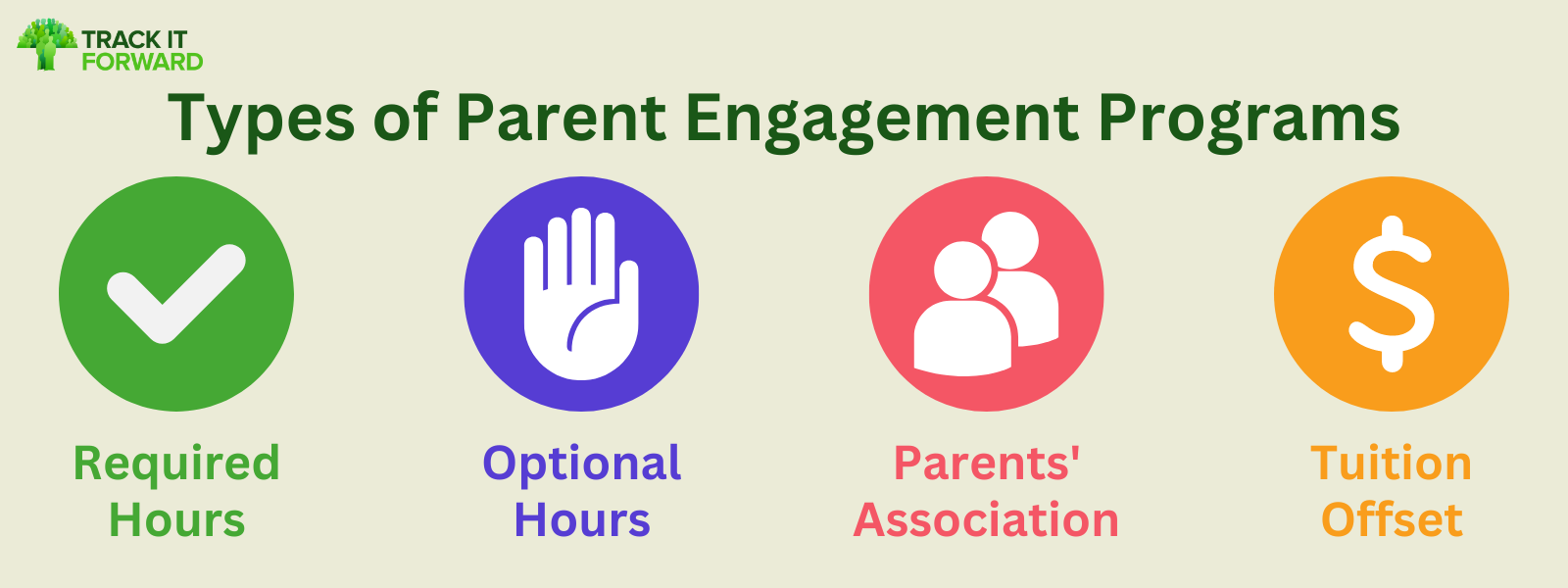
Parent engagement plays an important role at any school. It can lead to improved student outcomes and contribute to overall school success. For parent involvement to be successful, it’s important to have a structured parent engagement program in place. Here at Track it Forward, we’re committed to fostering increased volunteering everywhere and especially at schools. Parent volunteers can help students and their schools thrive, as long as there is good communication and organization.
We’ve put together a list of five steps to start a successful parent engagement program that your school can use no matter what stage of program development you’re in. These steps are based on parent program data we’ve collected as well as national research from institutions such as the U.S. Department of Education and the National Parent Teacher Association.
 Parent engagement in schools has been shown to have a positive impact on student outcomes. Engagement includes family-school communication, volunteering in school, and school-based family engagement activities. According to the U.S. Department of Education’s State Support Network1, studies show that parent engagement is linked to the following:
Parent engagement in schools has been shown to have a positive impact on student outcomes. Engagement includes family-school communication, volunteering in school, and school-based family engagement activities. According to the U.S. Department of Education’s State Support Network1, studies show that parent engagement is linked to the following:
- Improved student motivation
- Higher grades and test scores
- Better attendance, behavior, and social skills
A school should serve as a community for all staff, faculty, students, and families. Promoting community engagement will result in better outcomes for all school stakeholders.
Types of Parent Engagement Programs
When it comes to creating a parent engagement program from scratch or building off an existing one, it’s important to take into account the different program types. The type of program your school decides to implement can affect program organization and program guidelines. Parent engagement program types include:
- Required family commitment hours
- Optional parent volunteer hours
- Parents' associations
- Tuition offset programs

Schools can have one or more of these programs, or some may be combined. For example, a school may have a required family commitment hours program and a parents’ association, or may require hours only for parents who are part of a tuition offset program, or they may have optional hours organized by the parents’ association.
5 Steps to Start a Parent Engagement Program
 Step 1: Choose a Program Type and Create Guidelines
Step 1: Choose a Program Type and Create Guidelines
The first step to starting a parent engagement program is to decide on a program type, which will affect the guidelines you put in place. Your type of school may also affect what type of parent program you can put in place. For example, some states prohibit charter schools from requiring parent volunteer hours2.
It’s important to consider state and federal regulations when creating a parent engagement program and determining the language you’ll use to describe the program. Private schools often have more flexibility and discretion when it comes to creating a parent engagement program and can require parent volunteer hours. Public schools may choose to create an optional hours program and incorporate an existing PTA as part of that.
Once you’ve decided on a parent engagement program type, you can organize it and create guidelines. A big part of a parent engagement program’s organization is management. Not all programs need a high level of oversight, but all should have some type of program manager or administrator. We have highlighted some of the more common ways to organize a program below.
Required Family Commitment Hours
A parent engagement program that requires a minimum number of volunteer hours per year needs to have clear guidelines in place. When working on guidelines and organization for a program like this, consider the following questions:
- Are there different requirements for two- vs. one-parent households?
- Are there different requirements for parents with two or more children at the school?
- Can extended family such as grandparents or aunts and uncles complete required hours?
- Is there an option to opt-out of volunteer hours by paying a fee or making a donation?
 A formal structure and program administrator is particularly critical to an engagement program that requires volunteer hours. Parents need to be able to reference a clear process and a contact person in order to successfully complete required hours, especially if there are repercussions for not completing the hours.
A formal structure and program administrator is particularly critical to an engagement program that requires volunteer hours. Parents need to be able to reference a clear process and a contact person in order to successfully complete required hours, especially if there are repercussions for not completing the hours.Program Example: A formal required hours program has several categories for volunteering, and parents are required to complete hours in more than one category, such as Traffic Duty and Classroom Helper. The program is managed by a Parent Engagement and Outreach Coordinator on the administrative staff. Parents can check in with this point person with questions about program requirements, volunteer opportunities, and more.
Optional Parent Volunteer Hours
Any school can implement an optional parent engagement program. The program should still have guidelines for ways parents can participate. For example, some volunteer opportunities may require parents to complete background checks or additional training. There may be additional incentives for volunteering, such as recognition and special events. It is still important for optional parent volunteer programs to have an organizational structure and program manager.
Program Example: This type of program is typically run by someone on the administrative staff who helps coordinate parents and match them with volunteer opportunities. This person will also coordinate any training or background checks for parent volunteers as needed.
Parents' Associations
Most schools have some type of parents’ association. They’re known by several names (and acronyms), such as Parent-Teacher Associations, Parent-Teacher-Student Associations, and Home and School Associations, to name a few. A parents’ association can operate as the sole parent engagement program at a school, or can exist alongside school-led parent volunteer programs. We’ll share an example structure for both.

Program Example 1: Schools that solely have a parents’ association for their parent engagement program may defer to the association leadership to coordinate parent volunteer opportunities. Many parents’ associations will have someone from the school involved as a liaison as well. The president of the parents’ association is typically the point person for other parents. Either the president themselves or other officers in the association will coordinate parent volunteer events and review hours.
Program Example 2: Schools with both a parents’ association and a school-run parent volunteer program can work with the parents’ association to engage more parents in school-run volunteer opportunities. Time spent in parents’ association meetings may also count toward volunteer hour requirements. In this scenario, the school-run parent engagement program will have some type of administrator that works closely with the head of the parents’ association.
Tuition Offset Programs
A tuition offset program can be a required or optional parent engagement program and is specific to private schools. In many cases, it is required. An optional version may offer a discount on tuition in exchange for volunteering at the school. Required versions typically mandate volunteer hours for parents who qualify for reduced tuition at the school. Like all required-hour parent engagement programs, it’s crucial to have specific guidelines in place and a program manager.
Program Example: In the case of tuition offset programs, there may be more than one program manager from the school involved. For example, this type of program may have a manager who coordinates opportunities and acts as a point person for parents, while a second administrator handles the financial aspect and applies tuition discounts based on reports of parent volunteer hours.
 Step 2: Communicate with Parents
Step 2: Communicate with Parents
No matter what type of parent engagement program your school decides to implement, communication is crucial to its success. In fact, effective communication is listed as one of the six National Standards for Family-School Partnerships by the National Parent-Teacher Association3.
Whether you’re starting a new parent engagement program or making changes to an existing one, you need to communicate this to the parents. The best way to do this is to have open and transparent communication that sets clear expectations and denotes a contact person.
You’ll need to communicate any new program plans for parent involvement and let parents know how, where, and when they can get involved. Be sure to communicate the guidelines your school has set in place. When building a communication strategy, we recommend you take a look at these indicators for achieving successful family-school communication from the National Parent Teacher Association3:
- Meet families’ communication preferences
- Make communication accessible by providing translation as needed
- Coordinate information-sharing
- Collect family feedback on programs
- Promote transparency and allow families to follow up
- Co-create engagement plans
- Co-develop communication expectations
- Provide training and resources for school-family communication
- Collect school staff and family feedback on communication
 Step 3: Provide a Variety of Volunteer Opportunities
Step 3: Provide a Variety of Volunteer Opportunities
The next step to get your parent engagement program going is to set up volunteer opportunities. It’s important to provide a variety of inclusive opportunities designed to meet parents where they’re at. One of the best ways to promote parent involvement in schools is to make it easy! Removing barriers to volunteering can encourage parents to volunteer more often.
 For example, overcome time constraints by providing volunteer opportunities outside of traditional work and school hours, or overcome language barriers by listing volunteer opportunities in multiple languages. The types of volunteer opportunities your school chooses to provide should depend on your specific parent population. Sending out a survey ahead of time to learn what types of opportunities parents prefer and what kind of skills they have and are willing to contribute is a great way to get started!
For example, overcome time constraints by providing volunteer opportunities outside of traditional work and school hours, or overcome language barriers by listing volunteer opportunities in multiple languages. The types of volunteer opportunities your school chooses to provide should depend on your specific parent population. Sending out a survey ahead of time to learn what types of opportunities parents prefer and what kind of skills they have and are willing to contribute is a great way to get started!
Examples of Parent Volunteer Opportunities
In-School Opportunities
- Traffic Duty
- Classroom Aid
- Event Volunteer
- Yearbook Design
- Class Photography
- Gardening
Remote Volunteer Opportunities
- Prep work for events or classrooms
- Online administrative tasks
- Marketing and PR
- Social Media
- Outreach
- Field Trip Planning
In-Kind Donations
- Provide snacks or baked goods for events and field trips
- Provide classroom supplies
- Provide team or club T-shirts
- Option to count a certain dollar amount donated as 1 hour of volunteering
 Step 4: Create an Event Calendar
Step 4: Create an Event Calendar
So now you have program guidelines, a communication plan, and volunteer opportunities. The next step is to create an event calendar and single location for parents to find and sign up for these opportunities! The best type of event calendar will collect RSVPs and tie into a system that also provides a way to track those hours and run reports (more on this in Step 5!). An event calendar can be used for more than just special events - use it to post ongoing shifts for recurring opportunities or to collect sign-ups for donations.
Since the event calendar is part of your school’s overall parent engagement strategy, it’s a good idea to keep the calendar and all related parent program information in one place. For example, you might have a page or section on your school website for parents. This should include all guidelines and requirements (if applicable) for your parent engagement program, contact information, an event calendar, and a way for parents to check their progress and log volunteer hours.
 Step 5: Track Parent Volunteer Hours
Step 5: Track Parent Volunteer Hours
The final step to starting a parent engagement program is tracking parent volunteer hours. Tracking hours is important for several reasons.
First, it’s absolutely essential for any program that has required hours. If there are requirements parents need to meet, they must be able to track and view their progress alongside administrators. Reports can be used to easily determine who has met the requirement, who qualifies for tuition offset, or who needs to pay a fee.
Tracking hours isn't just for required-hour programs! All programs can benefit from reporting on parent engagement. By tracking hours across different categories, school administrators can gain insight into their program and how parents get involved. For example, reports can show:
- How many parents volunteer
- Which parents volunteer
- When they volunteer
- Which volunteer opportunities are most popular
- And more!
Regular reporting is important to measure the success of a parent engagement program and make adjustments to improve it in the future. The National Parent Teacher Association’s Standards for Family-School Partnerships states that all schools should strive to “track family engagement data and regularly examine it to identify gaps in access”3.

The Best Way to Track Parent Engagement Hours
There are several ways to track parent volunteer hours. Some common free solutions include using paper forms or Google forms. However, these have serious limitations. There is no transparency for parents in how many hours they’ve completed, and the process is time-consuming for administrators who need to aggregate hours and create reports. There is also greater room for error and missed hours.
The best way to track parent engagement is with a volunteer time tracking software like Track it Forward. Track it Forward has been helping schools track parent engagement for more than a decade and has plenty of school-friendly features, such as:
- Mobile App
- Event Caledar
- Milestones/Requirements Tracking
- Ability to send mass emails and texts
- Ability to embed calendar and hours log on school website
- And more!
With Track it Forward, parents can easily log their own volunteer hours, sign up for events, and track progress toward requirements. Program managers can list events, communicate with volunteers via email or text, and run reports.
In summary, the five steps to create a successful parent engagement program are:
- Choose a Program Type and Create Guidelines
- Communicate with Parents
- Provide a Variety of Volunteer Opportunities
- Create an Event Calendar
- Track Parent Volunteer Hours
By following these five steps, any school can start a parent engagement program! Throughout each step, keep in mind ways you can make the program more inclusive and accessible. Can you provide extension or reduced hours options in a required-hours program? Can you send different types of communication in different languages? Increasing access reduces the barriers to volunteering and will help parents get involved and stay involved! Parents, students, and school staff will benefit from the creation of a lasting and inclusive parent engagement program.
Sources:
Jacques and Villegas, "Strategies for Equitable Family Engagement" (State Support Network, U.S. Department of Education, 2018).
Potter and Nunberg, "Scoring States on Charter School Integration" in Report: Diverse Charter Schools (The Century Foundation, 2019).
"National Standards for Family-School Partnerships" (Center for Family Engagement, National Parent-Teacher Association, 2021).
FAQ: Starting a Parent Engagement Program
1. What is a parent engagement program?
A parent engagement program is a structured initiative designed to encourage parents and families to participate in school activities and their child's educational journey. Successful parent engagement programs support parents as active and valuable participants of the school community. These programs promote collaboration between families and schools to improve student outcomes and build community.
2. Why is parent engagement important in schools?
Parent engagement has been shown to improve student motivation, attendance, behavior, and academic achievement. Schools with strong parent involvement often experience higher satisfaction among families and more support for school initiatives.
3. How do I start a parent engagement program at my school?
This article outlines five key steps to starting a parent engagement program at your school.
- Assess your school community's needs and barriers.
- Set realistic goals and expectations for parent participation.
- Create diverse and inclusive volunteer opportunities.
- Establish clear communication channels.
- Use tracking tools to manage and report engagement and volunteer activity.
4. What are common challenges in increasing parent involvement?
Common challenges include limited time availability for parents and coordinators, lack of awareness about opportunities, and unclear communication or expectations. Schools can address these challenges by providing accessible, flexible volunteer opportunities, multilingual materials, and consistent, clear outreach.
5. What tools can help manage parent volunteer programs?
Parent engagement platforms like Track it Forward can simplify the process by allowing parents to log volunteer hours, sign up for events, and track progress. These tools also help school administrators generate reports and communicate effectively.
6. How can schools encourage more parents to participate?
Offer a variety of opportunities, including at-home and off-hours tasks. Clearly communicate the impact of volunteering, provide recognition or incentives, and emphasize how involvement supports their child's success.
7. What types of activities can be included in a parent engagement program?
Parent volunteer activities might include classroom support, event planning, fundraising, administrative tasks, or even participation in parent-teacher conferences. Tailor opportunities to your school's needs, families' skills and availability, and show that you value their time commitment.
8. How do you track and measure parent engagement success?
Use data such as participation rates, volunteer hours logged, and feedback from families and teachers. Tools like Track it Forward offer dashboards and reports that can help schools coordinate events, monitor progress, and adjust programs accordingly.
9. How can we make parent engagement more inclusive?
Offer multilingual communication, consider cultural norms, provide transportation or childcare when needed, and ensure all families feel welcomed and valued. Design engagement opportunities that reflect the diversity of your school community. Show parents you value their time by providing volunteer credit for regular programs like back-to-school nights and parent-teacher conferences.
10. Where can I learn more or get support to launch a parent program?
Sign up for the parent engagement newsletter to get more resources on parent engagement and tracking parent volunteer activity. Learn more about how Track it Forward software works for schools here.
 Last updated by
Last updated by